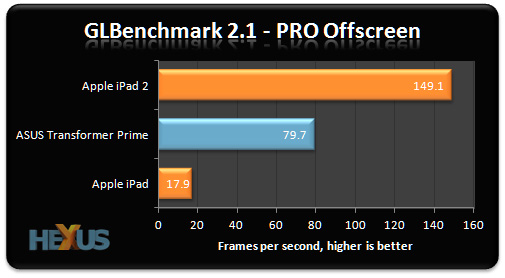Performance
Benchmarking a cutting-edge quad-core tablet isn't as easy as you'd think. There isn't a vast selection of benchmark utilities available, those that are don't always stress multiple cores, and few are cross-platform compatible - making it difficult to compare the Transformer Prime with the iPad.
We're looking to optimise our benchmark suite with upcoming utilities in the very near future (and we're open to suggestions), but for now we've run a wide range of tests to give you a general idea. Keeping things simple, all tested tablets are fully charged and plugged into the mains during testing, no other background apps are left open, and Transformer Prime is set to run using the "normal" power profile (the quickest available).

Getting the show started, SunSpider is used to measure the JavaScript performance of different browsers. In this test, the iPad 2 and Transformer Prime are closely matched, and both are a significant step up from the first-generation iPad.

BrowserMark, another free online benchmark from Rightware, tells us much of the same; the iPad 2 and Transformer Prime are neck and neck in terms of browser performance, and the numbers reflect our own browsing experiences.

Here's a test that really shows a difference between the three benchmarked tablets. We commented on the fact that Android 3.x can occasionally leave you waiting for apps to load, and nowhere is that more apparent than the initial boot.
Turning each of the devices on from a complete off state, we found that the iPad 2 on average booted to the lock screen in 16.8 seconds. The Transformer Prime takes almost a minute-and-a-half to kick into action. Of course, you could leave the device in standby - Tegra 3's fifth companion core shouldn't drain too much battery - but the test is nonetheless a good indication of how well optimised the respective platforms are.

Switching our focus to each tablet's integrated GPU, we use the GLBenchmark to measure the OpenGL performance of the three different processors; Prime's Tegra 3, the iPad 2's A5 and the iPad's A4.
The results come as a surprise. NVIDIA is a GPU company, and we were expecting Tegra 3 to breeze past Apple's A5 in terms of OpenGL performance, but it isn't even close. We always knew the iPad 2 was quick, but these benchmarks show just how much of an improvement the A5 really was.

The second GLBenchmark test tells a similar story; the Transformer Prime is good, but despite being considerably later to market, it's still playing catch up with the iPad 2. Is it just a case of software that lacks optimisation for a quad-core processor? It's possible, and we'll be re-running all of the above benchmarks when Ice Cream Sandwich is released.
If you're interested in comparing Transformer Prime performance with your own Android device, here are a bunch of additional benchmark results for reference:
Benchmark |
ASUS Transformer Prime |
|
|---|---|---|
| LinPack | Single-thread | 47.9 MFLOPS |
| Multi-thread | 93.1 MFLOPS |
|
| AnTuTu | Total Score | 10,755 |
| RAM | 2,142 |
|
| CPU Integer | 3,619 |
|
| CPU Float-Point | 2,799 |
|
| 2D Graphics | 285 |
|
| 3D Graphics | 1,195 |
|
| Database IO | 375 |
|
| NenaMark 1 | Total Score | 58.1 fps |
| NenaMark 2 | Total Score | 49.6 fps |









